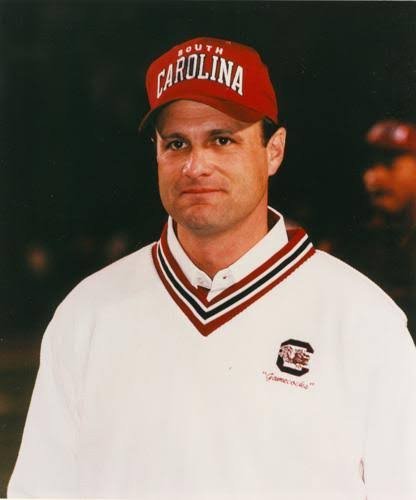A Coach’s Journey: Sparky Woods Reflects on His USC Legacy and the Road to the SEC
By Alan Piercy (originally published via the South By Southeast newsletter)
Sparky Woods’ voice came through the phone like a familiar tune from the early ’90s — calm, gracious, and steeped in the genteel tones of East Tennessee. Despite a career spent battling on college football’s toughest sidelines, Woods still speaks with the humility and warmth of someone you’d trust to coach your son.
True to form, Woods began the conversation with an apology — for not calling sooner to say he enjoyed my book, A Gamecock Odyssey, which chronicles the University of South Carolina’s independent era (1971–1991). I had passed along a copy through a mutual friend in Chapel Hill without expecting a reply.

“Thanks, Coach, and no worries. You’ve been pretty busy.”
Busy, indeed. Woods recently wrapped up a 50-year career in college football and relocated to Alabama after his final stop coaching at North Carolina.
Most Gamecock fans remember Woods as the man who led USC into the Southeastern Conference in 1992. His tenure helped bridge the gap from the chaotic independence of the Carlen and Morrison years to the championship-caliber days of Lou Holtz and Steve Spurrier.
Woods earned his shot at Columbia after a successful five-year stint at Appalachian State, where he won two Southern Conference titles and was named SoCon Coach of the Year three times. His Mountaineers faced Joe Morrison’s Gamecocks three times during that span — all losses — but Woods remembers Morrison with deep respect.
“Coach Morrison was great to me,” Woods said.
Still, he was well aware of the institutional cloud hanging over USC. “I knew about the steroid deal,” he admitted. “At 35, I thought I better grab this opportunity while I can. I was smart enough to know it was not the best time to take the job… but I felt blessed.”
Following Morrison’s death in February 1989, Woods assumed Dick Sheridan would take the job. “I thought… they’re going to hire Dick Sheridan, and I might have a chance to go to NC State.”
But Sheridan turned the Gamecocks down, opening the door for Woods.
On February 21, 1989, Sparky Woods — just 35 years old — was named the 28th head coach in South Carolina football history. He arrived with a winning record and a squeaky-clean reputation.

A Promising Start, a Crushing Setback
Woods inherited a talented squad in 1989: QB Todd Ellis, RB Harold Green, WR Robert Brooks, and defensive stars like Corey Miller and Patrick Hinton.
The Gamecocks surged to a 5-1-1 start, including an emotional win over Georgia Tech two days after Hurricane Hugo and a major road victory at Georgia.
But tragedy struck in late October. Against NC State, Ellis suffered a season-ending knee injury on just the third play. The Gamecocks never recovered, finishing the year 6-4-1. Though they received a bowl invite, the university declined it — a decision Woods later regretted.
“The Independence Bowl called and offered us a chance… I thought I was being a team guy, and I really wasn’t. It was really not fair to the players — the seniors especially.”
The Road to the SEC
In 1990, USC again started strong, going 3-0 with wins over Duke, UNC, and Virginia Tech. During warmups in Blacksburg, QB Bobby Fuller accidentally pegged a young Hokie ball boy with a pass. That boy? Shane Beamer — now USC’s current head coach.
“He came up and said I hit him with a ball when he was a little kid,” Fuller recalled, laughing.
Meanwhile, seismic shifts were happening behind the scenes. USC, Miami, and Florida State were all chasing conference invitations. Most fans — and Woods himself — assumed the ACC was their likely destination.

“I thought we’d get back in the ACC… It made the most sense.”
Polls backed that up. But in a surprise move, the ACC offered FSU. Soon after, the SEC extended an invitation to South Carolina.
Woods had done enough to earn the trust of SEC Commissioner Roy Kramer — the same man who once warned him, “Son, we know you’re gonna mess up again, and we don’t want to give you the death penalty.”
Kramer was referencing NCAA concerns dating back to Morrison’s era. But Woods had stabilized the program and helped secure USC’s future.
Yet even in 1990, controversy loomed. After a strong start, USC was stunned by I-AA The Citadel. “It was the first time they’d beaten us since 1950,” Woods remembered.
The Gamecocks limped to another 6-5 finish and were again passed over for bowl play — a second straight snub that Woods now calls a mistake.
“I wish I had fought for [it]. That was a huge mistake, maybe one of the biggest we made.”
A Legacy in Progress
Despite the frustrations, Woods brought stability. USC posted four straight winning seasons for the first time since the 1920s. He brought discipline, structure, and vision to a program long beset by controversy.
Ironically, it was Roy Kramer — the man who once questioned USC’s future — who helped usher the Gamecocks into the SEC because of the foundation Woods helped lay.
After a tough 3-6-2 season in 1991, Woods prepared to lead South Carolina into the Southeastern Conference — a new era filled with promise and peril.
Coming soon in Part II: Woods reflects on life in the SEC and the legacy he left behind at South Carolina.



